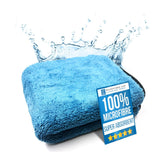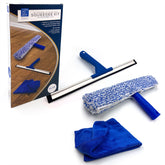How to Remove and Prevent Mould Creeping into Your Home!

Mould grows due to a combination of moisture, warmth, and organic matter. It is a type of fungus that thrives in damp environments with poor ventilation. When the conditions are right, mould spores present in the air land on surfaces and begin to grow. Organic materials, such as wood, fabric, or paper, provide nourishment for the mould to feed on. This process leads to the formation and spread of mould colonies.
To remove mould and mildew, here are some steps you can follow:
1. Safety Precautions: Wear protective gear such as gloves, goggles, and a mask to prevent exposure to mould spores.
2. Ventilation: Open windows or use fans to ensure proper ventilation in the area before starting the removal process.
3. Identify the Source: Locate the source of moisture that is causing the mould growth. Addressing the root cause is essential to prevent future growth.
4. Dry the Area: Use a dehumidifier or fan to dry the affected area thoroughly. Mould thrives in damp environments, so it is crucial to eliminate excess moisture.
5. Scrubbing: Mix a solution of equal parts water and bleach or vinegar. Alternatively, you can use a commercial mould and mildew cleaner. Scrub the affected surfaces, like walls, tiles, or grout lines, using a brush or sponge.
6. Rinse: After scrubbing, rinse the area with clean water to remove any remaining cleaning solution or residue.
7. Dry Again: Once the surfaces are thoroughly rinsed, use fans or open windows to ensure everything is completely dry. Proper drying prevents mould from returning.
8. Dispose of Contaminated Items: If mould has affected porous materials like carpets, upholstery, or clothing, it may be necessary to discard them, as it can be challenging to remove mould from these items completely.
Remember that extensive mould growth or severe mould-related health symptoms may require professional assistance.
Here are some tips on how to avoid mould:
1. Proper ventilation: Mould thrives in moist and stagnant air. Make sure to open windows or use ventilation systems to keep the air flowing and prevent excessive moisture buildup.
2. Monitor humidity levels: Maintain a humidity level between 30-60%. Consider using a dehumidifier or air conditioner to regulate moisture levels.
3. Fix leaks promptly: Any leaks in pipes, roofs, or windows should be fixed immediately to prevent water accumulation, which can lead to mould growth.
4. Use mould-resistant products: When remodelling or renovating, look for mould-resistant building materials such as drywall, paints, and insulation designed to inhibit mould growth.
5. Keep moisture-prone areas dry: Regularly clean and dry areas prone to moisture, such as bathroom walls, shower curtains, and kitchen sinks. Wipe down surfaces after use and consider using an exhaust fan to reduce moisture buildup.
6. Avoid carpeting in wet areas: Carpets can collect moisture, providing an ideal environment for mould growth. Instead, use area rugs that can be easily cleaned and dried.
7. Properly ventilate and maintain appliances: Ensure that appliances that produce moisture, such as clothes dryers and stoves, are vented properly to the outside. Routinely clean and maintain these appliances to prevent mould growth.
8. Clean regularly: Regularly inspect and clean areas prone to mould growth, such as sinks, showers, and basements. Use mould-killing agents or natural alternatives such as vinegar or hydrogen peroxide to remove any visible mould.
9. Monitor indoor plants: Overwatering indoor plants can contribute to excess moisture and mould growth in the soil and surrounding areas. Follow proper watering guidelines and ensure proper drainage.
10. Maintain proper insulation: Insulate surfaces exposed to cold temperatures to prevent condensation, as moist surfaces provide an environment suitable for mould. Proper insulation can help prevent this.
Remember, prevention is key when it comes to mould. By following these tips and promptly addressing any moisture issues, you can significantly reduce the risk of mould growth in your home.









































